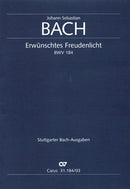| 作曲者 | Johann Sebastian Bach (1685-1750)・ヨハン・セバスティアン・バッハ |
| タイトル | Erwünschtes Freudenlicht, BWV 184(ヴォーカル・スコア) |
| サブタイトル | Cantata for the 3rd Sunday of Pentecost |
| 出版社 | Carus・カールス |
| 楽器編成(詳細) | Soli SAT,Coro SATB,2 Fl,2 Violins,Viola,Basso continuo |
| 品番 | M007050467 |
| 校訂者 | Reinhold Kubik |
| 編曲者 | Paul Horn |
| 難易度 | 中級 |
| 言語 | ドイツ語・英語 |
| 形状 | 44 ページ・19 x 27 cm・122 g・ソフトカバー |
| 演奏時間 | 25分 |
| 作曲年 | 1724年 |
| 出版年 | 1984年 |
| 出版番号 | CV 31.184/03 |
| ISMN | 979-0-007-05046-7 |
| サンプル | https://www.carusmedia.com/images-intern/medien/30/3118403/3118403x.pdf |
The Pentecost cantata “Desired ray of light” BWV 184 is based on a Köthen composition, probably a congratulatory cantata, whose instrumental parts (only these have survived) Bach reused in the Leipzig Pentecost cantata. Only the chorale setting was evidently newly composed. Despite the narrow leeway that the already finished composition left for the librettist, he nevertheless succeeded in crafting a coherent Pentecost text. The fact that the cantata begins with a long tenor accompagnato with two flutes followed by a pastoral duet is surprising. The placing of the chorale not at the end of the work but before the concluding chorus is unusual. Bach was evidently aware of the effect that the ending of this lively movement would have and wanted to retain this in its sacred form as well. The sacred version was first performed on the third day of Pentecost in 1724, probably after a parody version of another Köthen cantata (BWV 173) had already been performed on the second day of Pentecost.



